Hey, remember, uh, a long time ago? When I said I was going to do a series on croissants? Whatever happened to that anyway? I certainly didn’t stop making croissants. I just stopped talking about it. I suck!
Part of the problem was that these, the second batch of croissants I made, were just so bad. And it was all my fault. Well, mostly my fault; really I blame the yeast.
This is one of the only recipes I’ve made that calls for fresh yeast. I know you can substitute instant yeast, but my grocery store sells the fresh stuff, and I was curious to try it.
It ended up being probably the worst bread I’ve ever made. Maybe my fresh yeast wasn’t so fresh? Clearly something went very, very wrong. These croissants were dense dense dense, without any trace of flakiness. My only other attempt at bread made with fresh yeast was a failure as well.
Definitely not a success, and it’s hard to fairly judge the recipe when so much of what went wrong was my fault. Still, I learned things: 1) No more fresh yeast for me. 2) I like Martha’s method for shaping the crescents, where she stretches the wider part of the triangle a bit so that the center of each croissant isn’t so thick. 3) And the obvious: if the rolls don’t look like they’ve risen, they probably haven’t, and it might be best not to bake them yet, even if it’s already been over twice as long as the recipe recommends.
I should really try this recipe again using the type of yeast I’m more familiar with, because I’m sure this attempt didn’t do it justice. When I do, I’ll be sure to update with a continuation of my experiments with croissants. And this time I’ll try not to wait six months.
One year ago: Asian Peanut Dip
Printer Friendly Recipe
Croissants (from Martha Stewart’s Baking Handbook)
Makes 2 dozen
If using dry yeast instead of fresh, heat the milk to about 100ºF, then stir in the yeast to dissolve. Let stand until foamy, about five minutes, and proceed with the recipe. The dough can be made ahead through all of the turns and frozen for up to three months; before using, defrost the dough in the refrigerator for twenty-four hours. After baking, croissants are best eaten within six hours.
2 cups cold milk
2 tablespoons honey
1½ pounds (about 4 ½ cups) bread flour, plus more for dusting
4 ounces (1 scant cup) unbleached pastry flour
½ cup sugar
1½ ounces fresh yeast, crumbled
1 tablespoon plus 1½ teaspoons salt
1¼ pounds (5 sticks) unsalted butter, cold
1 large egg, lightly beaten
1. Make the dough package: Pour the milk and honey into a 1-quart liquid measuring cup, and stir to combine; set aside. In the bowl of an electric mixer fitted with the dough hook, stir together 1 pound 6 ounces (about 4¼ cups) bread flour, the pastry flour, sugar, yeast, and salt; stir to combine. Add milk mixture, and mix on low speed until the dough just comes together, 2 to 3 minutes.
2. Turn out dough onto a lightly floured work surface; gently knead to form a smooth ball, about 45 seconds. Wrap in plastic and refrigerate at least 1 hour or overnight.
3. Make the butter package: Lay the butter sticks side by side on a piece of plastic wrap, and sprinkle with the remaining 2 ounces (about ¼ cup) flour. Pound with a rolling pin until flour is incorporated, and roll into an 8-inch square. Wrap tightly and refrigerate for at least 1 hour or overnight.
4. Remove dough package from the refrigerator; place on a lightly floured work surface. Roll out to a 16-by-10-inch rectangle, about ½ inch thick, with a short side facing you. Remove butter package from the refrigerator; place on the bottom half of the dough; fold the top half of the dough over the butter, and pinch the edges to seal.
5. Roll out the dough to a 20-by-10 rectangle about ½ inch thick, with a short side facing you; keep the corners as square as possible. Remove any excess flour with a dry pastry brush. Starting at the far end, fold the rectangle in thirds, as you would a business letter. This completes the first of three turns. Wrap in plastic and refrigerate for 1 hour.
6. Repeat rolling and folding as above two more times, starting with the flap opening on the right, as if it were a book, and refrigerate at least 1 hour between turns. To help you remember how many turns have been completed, mark the dough after each: Make one mark for the first turn, two for the second, and three for the third. After the third, wrap dough in plastic, and refrigerate 6 to 8 hours, or overnight.
7. Turn out chilled dough onto a lightly floured work surface. Roll out the dough to a 30-by-16-inch rectangle. (If the dough becomes too elastic, cover with plastic wrap, and let rest in the refrigerator for 10 minutes.) Using a pizza wheel or pastry cutter, cut the dough in half lengthwise to form two 30-by-8-inch rectangles. Stack one piece of dough on top of the other, lining up the edges. Using the pizza wheel, cut dough into triangles, each with a 4-inch base (you will have scraps of dough at both ends). Cut a 1-inch slit in the center of the base of each triangle. Place triangles in a single layer on a clean work surface.
8. To shape croissants, stretch the two lower points of each triangle to enlarge the slit slightly. Fold the inner corners formed by the slit toward the outer sides of the triangles, and press down to seal. Using your fingertips, roll the base of each triangle up and away from you, stretching the dough slightly outward as you roll; the tip should be tucked under the croissant. Pull the two ends toward you to form a crescent. Transfer the crescents to two parchment-lined baking sheets, 2 inches apart (12 on each sheet). Cover loosely with plastic wrap, and let rise in a warm place until very spongy and doubled in bulk, 45 to 60 minutes.
9. Preheat the oven to 400ºF, with the racks in the upper and lower thirds. Lightly brush crescents with the beaten egg. Bake, rotating sheets halfway through, until the croissants are puffed and golden brown, about 20 to 25 minutes. Transfer sheets to a wire rack to cool. Serve warm or at room temperature.
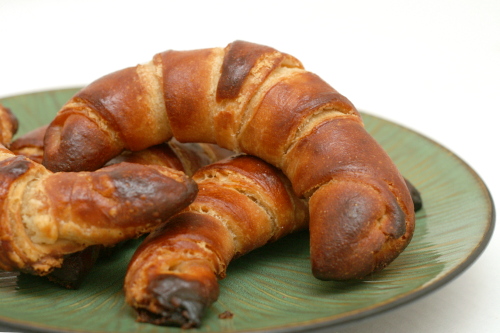
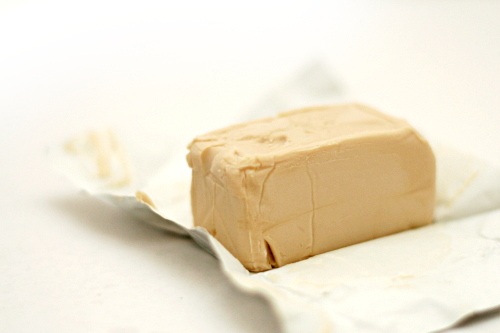
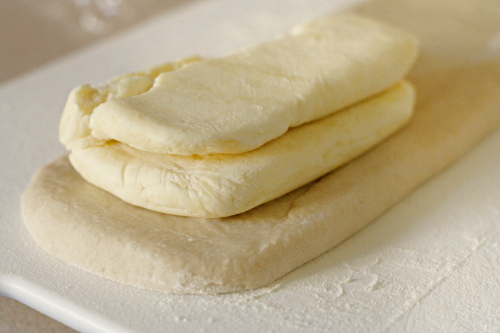
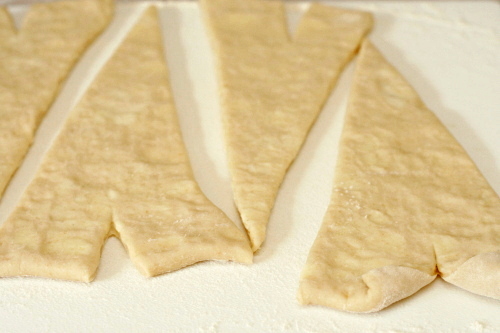
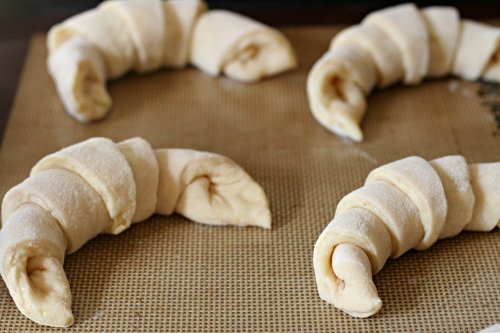


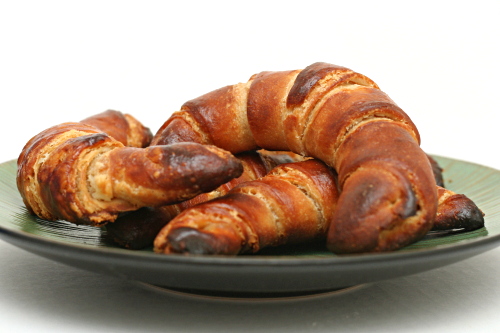






They’re looking pretty darned good to me! Thanks for tip about elongating the triangles, I wondered why mine looked such funny shape the one time I made them. I will have to try again.
Hey, Bridget! I used to work at a bakery making croissant from scratch every day, so maybe I can help.
It looks like maybe the butter block isn’t spreading all the way out to the edges of the dough. When you look at the rolled out rectangle, sometimes you can see where the outline of the butter inside might stop a few inches short of the edges of the dough. A simple cheat is to take a pizza cutter and trim away the edges without butter, then lay those strips of dough in the center of the rectangle, and continue folding. Otherwise, the dough that doesn’t get the butter will turn dark and bready instead of flaky.
Hope that helps!
Well kudos to you for trying to make croissants from scratch! I’ve owned Martha’s Baking Handbook for years now and still haven’t attempted them. I look forward to the rest of your posts about experimenting with them!
Well, congrats on your croissants. I am not brave enough to work on croissants, I have never tried baking any… Is that a shame for a French girl??
Hahaha… those are ugly. 😉 But I have no room to talk because have you seen my croissants? Oh wait, I haven’t ever made them!
I absolutely adore your blog, and I love that you post your failures as well as triumphs. It makes you human! 😀
I love croissant with chocolate inside. So yummy. I’ve never made them.
Do try them again. I don’t think it’s you. If there was no rise, maybe the yeast wasn’t alive and kicking anymore.
You have no idea how many times i’ve made croissants and they NEVER turned out right! If I figure it out one day i’ll be sure to tell you how i did it!
I’m impressed that you even tried to use fresh yeast- I ALWAYS use dry because I’m scared of the fresh stuff! Definitely try them again- the rolling method does look beautiful!
I come from Hungary where we use fresh yeast quite often with all sorts of dough. One thing is always the same, however, and that is not mixing the yeast in with the flour and other dry ingredients, but preparing it separately. That is, warming up a cup of milk a little, adding some sugar to it, and than the yeast that’s been crumbled to pieces. And than you have to wait for the yeast to rise. 🙂
If the quality of the yeast is good and if it’s really fresh, it should double or even triple in size, mix with the milk and result in a very strange new substance, a bit grey too.. But don’t be afraid really. It’s just that you have to choose a container for it that is tall so that the yeast has room to grow so to say.
When it’s done, you can mix it with the other ingredients, the flour, the eggs, the butter or whatever there is, and of course you have to let it rest and grow. And grow it will. 🙂
It might not be perfect for the first time, but it might as well be, a lot depends on the quality of the yeast. Either way, yeast dough is so yummie, please do try again. 🙂
Kata I agree with you thats how I learned too. Ive actually tried this recipe a long time ago and really don’t recommend it. It calls for too much butter. I followed the instructions, but when I went to bake it the butter melted to fast and started a fire. This is the only recipe I’ve seen that calls for so much butter.